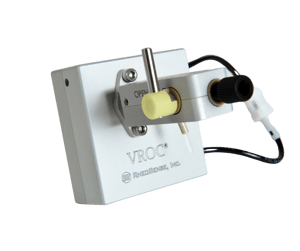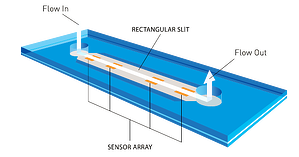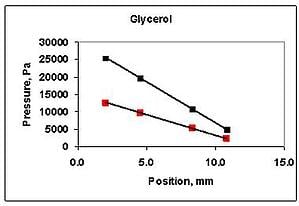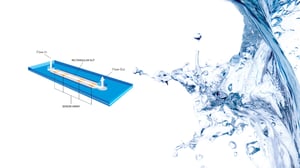How It Works
All RheoSense viscometers are powered by our patented VROC® technology.

VROC® Technology
VROC (Viscometer-Rheometer-on-a-Chip) combines microfluidic and MEMS (Micro-Electro-Mechanical Systems) technologies to measure dynamic viscosity over a wide dynamic range of operation. RheoSense's viscometers offer a cost-effective alternative for the complete extensive viscosity characterization over wide dynamic rages that are essential in the production of complex liquids (i.e. Non-Newtonian).
Compared to conventional viscometers and rheometers, RheoSense's microfluidic devices offer several advantages:
- Require just a few micro-liters per measurement
- Allow characterization of both Newtonian & non-Newtonian fluids
- Enable high shear rates without flow instabilities
- Prevent evaporation and contamination of samples
- Render high throughput due to a simple flow-through design
"VROC® is capable of making measurements not possible with other instruments ... the ability of the RheoSense viscometer to measure very small sample quantities is also useful. We have found the instrument to be accurate and reliable."
More Accurate Viscosity Measurements
Furthermore, VROC® quantifies true viscosity of fluids, as opposed to most conventional viscometers that only approximate the apparent properties of the material.
Why MEMS and Microfluidics for Viscosity?
Microfluidic devices offer precise control over the flow characteristics and reduce the volume required for measurements. Additionally microfluidic devices enable high throughput measurement and versatility to reduce cost.
MEMS devices integrate mechanical elements, sensors, actuators, and electronics on a common silicon substrate, using micro-fabrication technology to allow for very high precision and a very small scale.
The combination microfluidics and MEMS technologies, has enabled RheoSense to redefine viscometry and develop smaller, smarter, and faster micro-liter viscometers, which can measure fluids' viscosity in a wide range of conditions. As a result, VROC® technology offers capabilities well beyond the limits of conventional viscometers.
Principle of Operation of VROC® Powered Viscometers
A VROC® cell reads viscosity by measuring the pressure drop as a test liquid flows through its rectangular slit microfluidic channel. Based on Hagen–Poiseuille flow, it is a well-known application of rheometry principles (K. Walters, Rheometry, Chapman and Hall, London, 1975), that is also listed in US Pharmacopeia chapter <914>.
 FIGURE 1. SCHEMATIC OF VROC® RECTANGULAR SLIT MICROFLUIDIC CELL.
FIGURE 1. SCHEMATIC OF VROC® RECTANGULAR SLIT MICROFLUIDIC CELL.
As the test liquid is forced to flow through the flow channel, the pressure sensor array measures pressure as a function of position. Figure 2 shows an example of the raw measurement data for two glycerol samples. Higher glycerol content would result in higher viscosity and a larger pressure drop through the micro-channel (black squares). On the other hand, lower concentration will result on lower viscosity and thus, a smaller pressure drop (red squares). Get our principle of operation application note for more information.
 FIGURE 2. PRESSURE AS A FUNCTION OF POSITION FOR LOW AND HIGH CONCENTRATION GLYCEROL SAMPLES.
FIGURE 2. PRESSURE AS A FUNCTION OF POSITION FOR LOW AND HIGH CONCENTRATION GLYCEROL SAMPLES.

